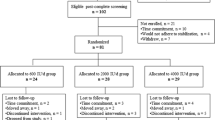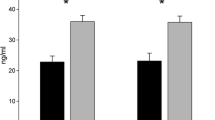Abstract
This study aimed to describe the association of vitamin D status at different stages of growth with bone measures in adolescence and early adulthood. There were 415 participants followed from age 8 to 16, and 201 further followed to age 25. Areal bone mineral density (BMD) at the spine, hip and total body was measured by dual-energy X-ray absorptiometry at ages 16 and 25, and tibial and radial trabecular and cortical bone microarchitecture by high resolution peripheral quantitative computerised tomography at age 25. Serum 25-hydroxyvitamin D (25OHD) concentrations were measured at ages 8, 16 and 25. Multivariable linear regression was used to analyse the association of 25OHD concentrations at three timepoints with bone measures at ages 16 and 25. The proportion of participants with vitamin D deficiency (< 50 nmol/L) was 11%, 43% and 41% at three timepoints, respectively. Serum 25OHD concentrations at age 8 were not significantly associated with any bone measures at age 16 or 25. Serum 25OHD concentrations at age 16 had a significant association with higher BMD at nearly all sites at ages 16 and 25 as well as lower radial porosity and more compact trabecular microarchitecture (higher density, increased number and reduced separation) at both the radius and tibia at age 25. Serum 25OHD concentrations at age 25 were only associated with hip BMD. Higher vitamin D concentrations in adolescence, to a lesser extent at age 25, have beneficial associations with BMD and bone microarchitecture in early adulthood. Optimising vitamin D status particularly during adolescence should be a priority.

Similar content being viewed by others
References
Ross AC, Manson JE, Abrams SA, Aloia JF, Brannon PM, Clinton SK, Durazo-Arvizu RA, Gallagher JC, Gallo RL, Jones G (2011) The 2011 report on dietary reference intakes for calcium and vitamin D from the Institute of Medicine: what clinicians need to know. J Clin Endocrinol Metab 96(1):53–58
Hilger J, Friedel A, Herr R, Rausch T, Roos F, Wahl DA, Pierroz DD, Weber P, Hoffmann K (2014) A systematic review of vitamin D status in populations worldwide. Br J Nutr 111(1):23–45
Glorieux FH (2003) Pediatric bone: biology & diseases. Elsevier, Amsterdam
Heaney R, Abrams S, Dawson-Hughes B, Looker A, Looker A, Marcus R, Matkovic V, Weaver C (2000) Peak bone mass. Osteoporos Int 11(12):985–1009
Seeman E (1994) Reduced bone density in women with fractures: contribution of low peak bone density and rapid bone loss. Osteoporos Int 4:S15–S25
Lehtonen-Veromaa MK, Möttönen TT, Nuotio IO, Irjala KM, Leino AE, Viikari JS (2002) Vitamin D and attainment of peak bone mass among peripubertal Finnish girls: a 3-y prospective study. Am J Clin Nutr 76(6):1446–1453
Zhu K, Oddy WH, Holt P, Ping-Delfos WCS, Mountain J, Lye S, Pennell C, Hart PH, Walsh JP (2017) Tracking of vitamin D status from childhood to early adulthood and its association with peak bone mass. Am J Clin Nutr 106(1):276–283
Sayers A, Fraser W, Lawlor D, Tobias J (2012) 25-Hydroxyvitamin-D3 levels are positively related to subsequent cortical bone development in childhood: findings from a large prospective cohort study. Osteoporos Int 23(8):2117–2128
Navarro MC, Sosa M, del Pino-Montes J, Torres A, Salido E, Saavedra P, Corral-Gudino L, Montilla CA (2007) Collagen type 1 (COL1A1) Sp1 binding site polymorphism is associated with osteoporotic fractures but not with bone density in post-menopausal women from the Canary Islands: a preliminary study. Aging Clin Exp Res 19(1):4–9
Uitterlinden AG, Ralston SH, Brandi ML, Carey AH, Grinberg D, Langdahl BL, Lips P, Lorenc R, Obermayer-Pietsch B, Reeve J (2006) The association between common vitamin D receptor gene variations and osteoporosis: a participant-level meta-analysis. Ann Intern Med 145(4):255–264
Deng HW, Mahaney MC, Williams JT, Li J, Conway T, Davies KM, Li JL, Deng H, Recker RR (2002) Relevance of the genes for bone mass variation to susceptibility to osteoporotic fractures and its implications to gene search for complex human diseases. Genet Epidemiol 22(1):12–25
Nishiyama KK, Shane E (2013) Clinical imaging of bone microarchitecture with HR-pQCT. Curr Osteoporos Rep 11(2):147–155
Dwyer T, Ponsonby A-L, Newman N, Gibbons L (1991) Prospective cohort study of prone sleeping position and sudden infant death syndrome. Lancet 337(8752):1244–1247
Zebaze R, Ghasem-Zadeh A, Mbala A, Seeman E (2013) A new method of segmentation of compact-appearing, transitional and trabecular compartments and quantification of cortical porosity from high resolution peripheral quantitative computed tomographic images. Bone 54(1):8–20
Yang Y, Pan F, Wu F, Squibb K, Thomson R, Winzenberg T, Jones G (2018) Familial resemblance in trabecular and cortical volumetric bone mineral density and bone microarchitecture as measured by HRpQCT. Bone 110:76–83
Zebaze R, Seeman E, Mbala A, Ghasemzadeh A, Mackie E, Bohte A (2015) Method and system for image analysis of selected tissue structures. U.S. Patent and Trademark Office, Washington, DC
Jin X, Jones G, Cicuttini F et al (2016) Effect of vitamin d supplementation on tibial cartilage volume and knee pain among patients with symptomatic knee osteoarthritis: a randomized clinical trial. JAMA 315(10):1005–1013. https://doi.org/10.1001/jama.2016.1961
Holick MF (2007) Vitamin D deficiency. N Engl J Med 357(3):266–281
Holick MF, Binkley NC, Bischoff-Ferrari HA, Gordon CM, Hanley DA, Heaney RP, Murad MH, Weaver CM (2011) Evaluation, treatment, and prevention of vitamin D deficiency: an endocrine society clinical practice guideline. J Clin Endocrinol Metab 96(7):1911–1930
Duke PM, Litt IF, Gross RT (1980) Adolescents’ self-assessment of sexual maturation. Pediatrics 66(6):918–920
Wu F, Laslett LL, Zhang Q (2015) Threshold effects of vitamin d status on bone health in chinese adolescents with low calcium intake. J Clin Endocrinol Metab 100(12):4481–4489
Perneger TV (1998) What’s wrong with Bonferroni adjustments. Bmj 316(7139):1236–1238
Wu F, Wills K, Laslett LL, Oldenburg B, Jones G, Winzenberg T (2017) Moderate-to-vigorous physical activity but not sedentary time is associated with musculoskeletal health outcomes in a cohort of Australian middle-aged women. J Bone Miner Res 32(4):708–715
Nguyen TV, Center JR, Eisman JA (2005) Femoral neck bone loss predicts fracture risk independent of baseline BMD. J Bone Miner Res 20(7):1195–1201
Ma D, Jones G (2003) The association between bone mineral density, metacarpal morphometry, and upper limb fractures in children: a population-based case-control study. J Clin Endocrinol Metab 88(4):1486–1491
Theintz G, Buchs B, Rizzoli R, Slosman D, Clavien H, Sizonenko P, Bonjour J-P (1992) Longitudinal monitoring of bone mass accumulation in healthy adolescents: evidence for a marked reduction after 16 years of age at the levels of lumbar spine and femoral neck in female subjects. J Clin Endocrinol Metab 75(4):1060–1065
McKay HA, Bailey DA, Mirwald RL, Davison KS, Faulkner RA (1998) Peak bone mineral accrual and age at menarche in adolescent girls: a 6-year longitudinal study. J pediatr 133(5):682–687
Yang Y, Wu F, Winzenberg T, Jones G (2018) Tracking of areal bone mineral density from age eight to young adulthood and factors associated with deviation from tracking: a 17-year prospective cohort study. J Bone Miner Res 33(5):832–839
Kuchuk NO, Pluijm SM, van Schoor NM, Looman CW, Smit JH, Lips P (2009) Relationships of serum 25-hydroxyvitamin D to bone mineral density and serum parathyroid hormone and markers of bone turnover in older persons. J Clin Endocrinol Metab 94(4):1244–1250
Kuchuk NO, van Schoor NM, Pluijm SM, Chines A, Lips P (2009) Vitamin D status, parathyroid function, bone turnover, and BMD in postmenopausal women with osteoporosis: global perspective. J Bone Miner Res 24(4):693–701
Ellis KJ, Shypailo RJ (1998) Bone mineral and body composition measurements: cross-calibration of pencil-beam and fan-beam dual-energy x-ray absorptiometers. J Bone Miner Res 13(10):1613–1618
Crabtree NJ, Shaw NJ, Bishop NJ, Adams JE, Mughal MZ, Arundel P, Fewtrell MS, Ahmed SF, Treadgold LA, Högler W, Bebbington NA, Ward KA, on behalf of the AST (2017) Amalgamated reference data for size-adjusted bone densitometry measurements in 3598 children and young adults—the ALPHABET study. J Bone Miner Res 32(1):172–180. https://doi.org/10.1002/jbmr.2935
Krueger D, Libber J, Sanfilippo J, Yu HJ, Horvath B, Miller CG, Binkley N (2016) A DXA Whole body composition cross-calibration experience: evaluation with humans, spine, and whole body phantoms. J Clin Densitom 19(2):220–225
Hollis BW (2000) Comparison of commercially available 125I-based RIA methods for the determination of circulating 25-hydroxyvitamin D. Clin Chem 46(10):1657–1661
Acknowledgements
This research was supported by National Health and Medical Research Council (Grant Number: APP1045408). FW was supported by an Arthritis Foundation Australia—Australian Rheumatology Association Heald Fellowship, funded by the Australian Rheumatology Association and Vincent Fairfax Family Foundation. FW is supported by a NHMRC Early Career Fellowship (APP1158661). GJ is supported by a Practitioner Fellowship, funded by the National Health and Medical Research Council (1117037). All authors would like to thank all the staff and participants involved in this study.
Author information
Authors and Affiliations
Contributions
GJ and TW contributed to study design. GJ, YY and TW helped with study conduct. YY and GJ involved in data collection. YY, FW and GJ contributed to data analysis. YY, GJ, FW and TW helped with data interpretation. YY and GJ involved in drafting manuscript. All authors contributed to revising manuscript content. All authors approved final version of manuscript. GJ takes responsibility for the integrity of the data analysis.
Corresponding author
Ethics declarations
Conflict of interest
Yi Yang, Feitong Wu, Tania Winzenberg, Graeme Jones declare that they have no conflicts of interest.
Human and Animal Rights and Informed Consent
Written informed consent was obtained from all participants and/or their parents or guardians. This study was approved by the University of Tasmania Human Research Ethics Committee.
Additional information
Publisher’s Note
Springer Nature remains neutral with regard to jurisdictional claims in published maps and institutional affiliations.
Electronic Supplementary material
Below is the link to the electronic supplementary material.
Rights and permissions
About this article
Cite this article
Yang, Y., Wu, F., Winzenberg, T. et al. The Association of Vitamin D in Youth and Early Adulthood with Bone Mineral Density and Microarchitecture in Early Adulthood. Calcif Tissue Int 104, 605–612 (2019). https://doi.org/10.1007/s00223-019-00529-w
Received:
Accepted:
Published:
Issue Date:
DOI: https://doi.org/10.1007/s00223-019-00529-w




